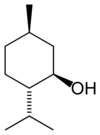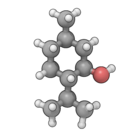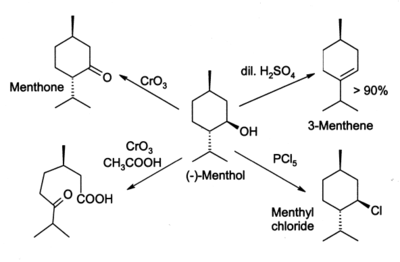Menthol
2007 Schools Wikipedia Selection. Related subjects: Chemical compounds
| Menthol | |
|---|---|
   |
|
| General | |
| Systematic name | 2-(2-Propyl)-5-methyl- 1-cyclohexanol |
| for racemic (−)-isomer | (2R)-(2-Propyl)-(5S)-methyl- (1R)-cyclohexanol |
| Other names | 3-p-Menthanol, Hexahydrothymol, Menthomenthol, peppermint camphor |
| Molecular formula | C10H20O |
| SMILES | CC1CCC(C(C1)O)C(C)C |
| Molar mass | 156.27 g/mol |
| Appearance | White or colorless crystalline solid |
| CAS number | [89-78-1], racemic [2216-51-5], (−)-isomer |
| Properties | |
| Density and phase | 0.890 g/cm3, solid (racemic or (−)-isomer) |
| Solubility in water | Slightly soluble, (−)-isomer |
| In ethanol, diethyl ether, acetone, chloroform acetic acid, hexane |
Soluble |
| Melting point | 36-38 °C (311 K), racemic 42-45 °C (318 K), (−)-form (α) 35-33-31 °C, (−)-isomer |
| Boiling point | 212 °C (485 K) |
| Chiral rotation [α]D | -50° at 18 °C, 10% EtOH soln. |
| Hazards | |
| MSDS | External MSDS |
| Main hazards | Irritant, flammable |
| NFPA 704 | |
| Flash point | 93 °C |
| R/S statement | R37/38, R41 S26, S36 |
| RTECS number | OT0350000, racemic OT0700000, (−)-enantiomer |
| Supplementary data page | |
| Structure & properties | n, εr, etc. |
| Thermodynamic data | Phase behaviour Solid, liquid, gas |
| Spectral data | UV, IR, NMR, MS |
| Related compounds | |
| Related alcohols | Cyclohexanol, Pulegol, Dihydrocarveol, Piperitol |
| Related compounds | Menthone, Menthene, Thymol, p- Cymene, Citronellal |
| Except where noted otherwise, data are given for materials in their standard state (at 25°C, 100 kPa) Infobox disclaimer and references |
|
Menthol is a covalent organic compound made synthetically or obtained from peppermint or other mint oils. It is a waxy, crystalline substance, clear or white in colour, which is solid at room temperature and melts slightly above. The main form of menthol occurring in nature is (-)-menthol, which is assigned the (1R,2S,5R) configuration. Menthol has local anesthetic and counterirritant qualities, and it is widely used to relieve minor throat irritation.
History and occurrence
There is evidence that menthol has been known in Japan for more than 2000 years, but in the west it was not isolated until 1771, by Gambius. (-)-Menthol (also called l-menthol or (1R,2S,5R)-menthol) occurs naturally in peppermint oil (along with a little menthone, the ester menthyl acetate and other compounds), obtained from mentha x piperita. Japanese menthol also contains a small percentage of the 1- epimer, (+)-neomenthol.
Structure
Natural menthol exists as one pure enantiomer, nearly always the (1R,2S,5R) form (bottom left of diagram below). The other seven stereoisomers are:
In the natural compound, the isopropyl group is oriented trans- orientation to both the methyl and alcohol groups. Thus it can be drawn in any of the ways shown:
In the ground state all three bulky groups in the chair are equatorial, making (-)-menthol and its enantiomer the most stable two isomers out of the eight.
There are two crystal forms for racemic menthol; these have melting points of 28 °C and 38 °C. Pure (-)-menthol has four crystal forms, of which the most stable is the α form, the familiar broad needles.
Applications
Menthol is included in many products for a variety of reasons. These include:
- In non-prescription products for short-term relief of minor sore throat and minor mouth or throat irritation
- Examples: lip balms and cough medicines
- As an antipruritic to reduce itching
- As a topical analgesic to relieve minor aches and pains such as muscle cramps, sprains, headaches and similar conditions, alone or combined with products like Camphor or Capsicum. In Europe it tends to appear as a gel or a cream, while in the US patches and body sleeves are very frequently used
- Examples: Tiger Balm IcyHot patches or knee/elbow sleeves
- In decongestants for chest and sinuses (cream, patch or nose inhaler)
- Examples: Vicks Vaporub
- In certain medications used to treat sunburns, as it provides a cooling sensation (then often associated with Aloe)
- As an additive in certain cigarette brands, for flavor, to reduce the throat and sinus irritation caused by smoking and arguably to reduce the bad-breath smokers experience and possibly improve the smell of second-hand smoke.
- Commonly used in oral hygiene products and bad-breath remedies like mouthwash, toothpaste, mouth and tongue-spray, and more generally as a food flavor agent e.g. in chewing-gum, candy
- In a soda as well as in a syrup to be mixed with water to obtain a very low alcohol drink or (brand Rickles in France). The syrup is/was also used to alleviate nausea, in particular motion sickness, by pouring a few drops on a lump of sugar.
- As a pesticide against tracheal mites of honeybees
- In perfumery, menthol is used to prepare menthyl esters to emphasise floral notes (especially rose)
- In first aid products such as "mineral ice" to produce a cooling effect as a substitute for real ice in the absence of water or electricity (Pouch, Body patch/sleeve or cream)
- In various patches ranging from fever-reducing patches applied to children's foreheads to "foot patches" to relieve numerous ailments (the latter being much more frequent and elaborate in Asia, esp. Japan: some variety use `functional protrusion' i.e. small bumps to massage ones feet as well as soothing them and cooling them down)
- In some beauty products such as hair-conditioners, based on natural ingredients (ex: St Ives)
Some supporters of the homeopathic theory of pharmacology believe that menthol interferes with the effects of homeopathic remedies. Its use is strongly discouraged for those seeking homeopathic cures, to the point of prohibiting the use of mint-flavored toothpaste. Currently no other reported nutrient or herb interactions involve menthol. Menthol is available as a dietary supplement or natural medicine in the form of peppermint oil. It is used in Eastern medicine to treat indigestion, nausea, sore throat, diarrhoea, colds, and headaches. (-)-Menthol has low toxicity: Oral (rat) LD50: 3300 mg/kg; Skin (rabbit) LD50: 15800 mg/kg).
In organic chemistry, menthol is used as a chiral auxiliary in asymmetric synthesis. For example, sulfinate esters made from sulfinyl chlorides and menthol can be used to make enantiomerically pure sulfoxides by reaction with organolithium reagents or Grignard reagents. Menthol is also used for classical resolution of chiral carboxylic acids, via the menthyl esters.
Synthesis
As with many widely-used natural products, the demand for menthol greatly exceeds the supply from natural sources. Menthol is manufactured as a single enantiomer (94% ee) by Takasago International Co. on a scale of 400 000 tonnes per year. The process involves an asymmetric synthesis developed by a team led by Ryoji Noyori:
The process begins by forming an allylic amine from myrcene, which undergoes asymmetric isomerisation in the presence of a BINAP rhodium complex to give (after hydrolysis) enantiomerically pure R- citronellal. This is cyclised by a carbonyl-ene-reaction initiated by zinc bromide to isopulegol which is then hydrogenated to give pure (1R,2S,5R)-menthol.
Racemic menthol can be prepared simply by hydrogenation of thymol, and menthol is also formed by hydrogenation of pulegone. For preparation of other isomers such as neomenthol, see ref. 1.
Chemical properties
Menthol reacts in many ways like a normal secondary alcohol. It is oxidised to menthone by oxidising agents such as chromic acid, though under some conditions the oxidation can go further and break open the ring. Menthol is easily dehydrated to give mainly 3-menthene, by the action of 2% sulfuric acid. PCl5 gives menthyl chloride.
Biological properties
Menthol's ability to chemically trigger cold-sensitive receptors in the skin is responsible for the well known cooling sensation that it provokes when inhalated, eaten, or applied to the skin. It should be noted that Menthol does not cause an actual drop in temperature. . In this sense it is similar to capsaicin, the chemical responsible for the spiciness of hot peppers (which stimulates heat sensors, also without causing actual temperature rise).




